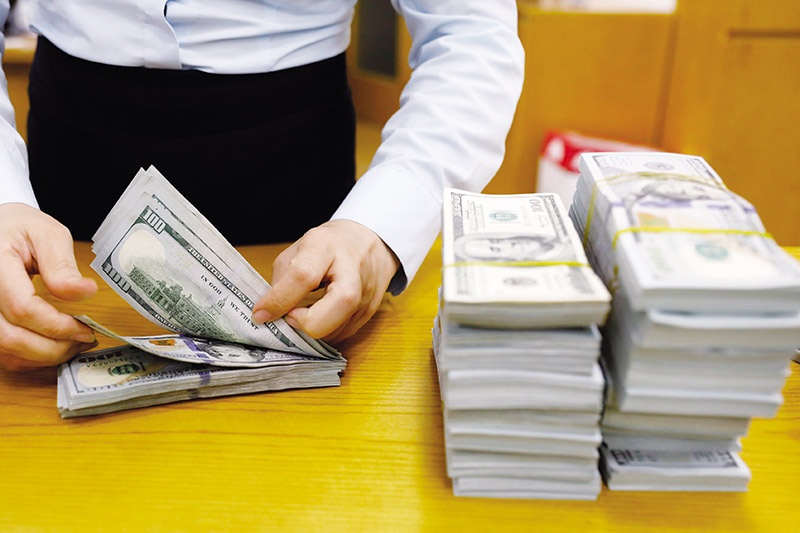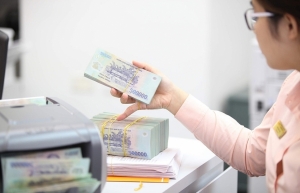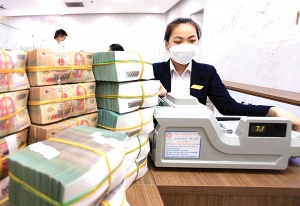Exchange rate pressure to soften by year end
Last weekend, the selling price of the US dollar fetched VND24,500 per dollar at major state lender Vietcombank, up nearly 4.4 per cent compared to the outset of this year. Similarly, the central exchange rate gained more than 2 per cent correspondingly.
Senior economist Le Xuan Nghia in a talk with VIR early this month, said that the higher exchange rate in the domestic market would be proportional to that in the global market.
In the year to date, the greenback rose about 4 per cent in value globally.
 |
Nghia noted that the US dollar remained strong as the US economy has rebounded positively thanks to robust growth of its weapons, as well as liquefied and petrochemical industries.
Many experts have the same mindset, assuming that albeit the Federal Reserve (Fed) doesn't raise the base rate in its November policy meeting, the Fed’s interest rate is at its peak in 22 years and the ‘expensive money era’ could prolong for some time now.
Phan Dung Khanh, head of Investment Advisory at Maybank Investment Bank believe the US dollar gaining in value came as the Fed could maintain its tightened monetary policy for longer.
“The Fed’s interest rate might be softened to 2.9 per cent in the next three years, meaning the US interest rate would be kept higher than the neutral interest rate at 2.5 per cent. In other words, the expensive money era could linger for at least three years more,” said Khanh.
Augmenting the US dollar in the global market and increasing speculation of the greenback in the domestic market due to the gap between VND and US dollar in the first half of this year, has underpinned a sharp rise in the VND-US dollar exchange rate.
In the past month, the central bank (SBV) has continually issued a huge volume surpassing $4.6 billion of 28-days treasury bonds to withdraw cash from the banking system, helping to narrow the gap in the interest rate between VND and US dollar-denominated deposits.
Khanh from Maybank remarked that this positive move had contributed to pushing up the interbank interest rate as well as stabilising the forex market.
Economist Le Xuan Nghia said, “SVB’s intervention by T-bond issuance is a smart move. Currently, forex supply is abundant. Moreover, the Fed is expected to begin reducing their interest rate from 2024. This will put a brake on dollar price and soother the exchange rate pressure in the forthcoming time.”
Nguyen Huu Huan, head of the Faculty of Finance at University of Economics Ho Chi Minh City, said that it was necessary for Vietnam to accept the exchange rate to lose 3-5 per cent in value to uphold exports.
The exchange rate might quickly be softened when the peak time for dollar demand has passed. In his view, there are a raft of factors underpinning exchange rate stability.
First, the trade balance in the first 10 months of this year saw a $24.61 billion trade surplus, compared to just $9.56 billion in the same period last year.
Second, disbursed foreign direct investment capital volume during the period reached an estimated $18 billion, up 2.4 per cent on-year, a record in the past five years.
In addition, inward remittance volume saw a stable growth.
Analysts at ACB Securities assume that although there is a risk to the exchange rate, the SBV has sufficient tools to maintain exchange rate and interest rate stability.
In their view, the SBV has two vehicles in the short-term: issuing T-bonds to withdraw cash or considering 3- to 6-month term dollar sell-offs for market intervention, in which, the latter is the final-case option.
From the SBV side, Deputy Governor Dao Minh Tu said that the dollar movement was proportional to that in the global market and the supply-demand situation.
“Businesses can put their mind at ease as the central bank shall act to phase out the dollar speculation mindset. The fruitful foreign reserves, growth of foreign direct investment flow and positive movements with other foreign currencies are the fundaments for a stable exchange rate,” Tu said.
 | Slight rate moves projected for year Since the outbreak of the pandemic, the State Bank of Vietnam (SBV) has slashed rates three times, in March, May, and October to aid the economy. The refinancing and rediscounting rate are now at a new record low of 4.0 per cent and 2.5 per cent, respectively, while interbank rates and bond yields have experienced a downward trend since June. |
 | Exchange rate spike not deemed an imminent threat The USD exchange rate on the morning of February 24 on the free market and banks both increased sharply compared to the previous session, exceeding the threshold of VND24,000. |
 | Exchange rate pressure to soothe by end of 2023: expert Pyon Young Hwan, director of Global Trading Centre at Shinhan Bank Vietnam, shared his take with VIR's Thuy Vinh on the interest rate situation globally and in Vietnam, and challenges and development prospects for the country’s economy in late 2023 and beyond. |
What the stars mean:
★ Poor ★ ★ Promising ★★★ Good ★★★★ Very good ★★★★★ Exceptional
Related Contents
Latest News
More News
- Tax sector wraps up 2025 and sets priorities for next year (December 25, 2025 | 14:00)
- A tipping point for digital and hybrid wealth management in Vietnam (December 23, 2025 | 13:33)
- $250 million deal targets women-owned SMEs, sustainable agriculture (December 22, 2025 | 17:40)
- Stock market posts resilient 2025 performance (December 19, 2025 | 18:17)
- Citi Vietnam receives 2025 AmCham CSR recognition (December 19, 2025 | 16:35)
- As global green supply chain reshapes, will Vietnam be left behind? (December 19, 2025 | 08:00)
- Banks gear up for massive capital increases (December 18, 2025 | 17:04)
- Securing capital and efficiency for Vietnam’s 2026-2030 growth ambitions (December 17, 2025 | 10:00)
- Energy sector in need of blended finance mechanisms (December 17, 2025 | 09:00)
- Vietnam still has room to mobilise capital for sustainable growth (December 17, 2025 | 08:57)

 Tag:
Tag:


























 Mobile Version
Mobile Version